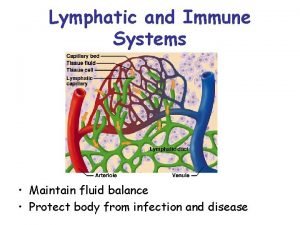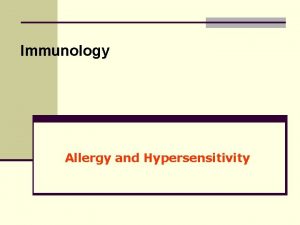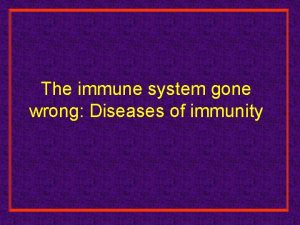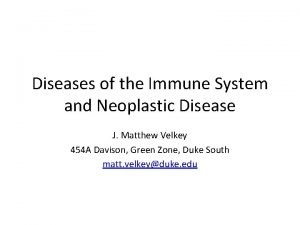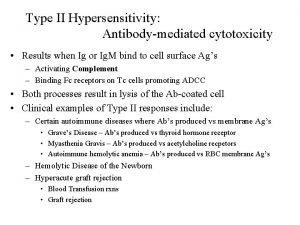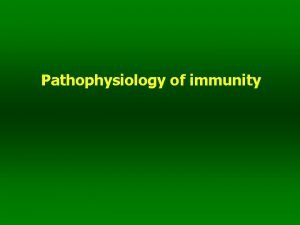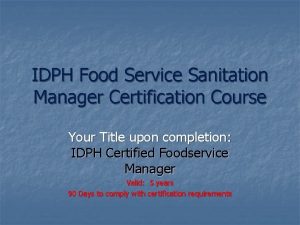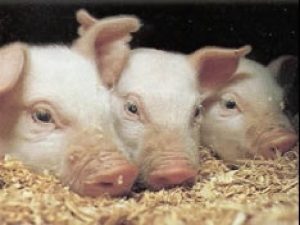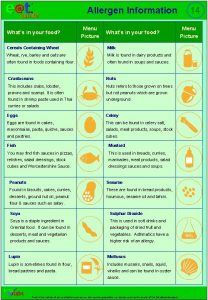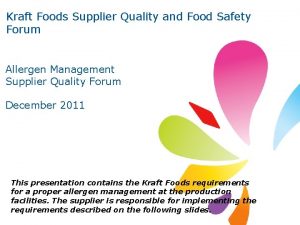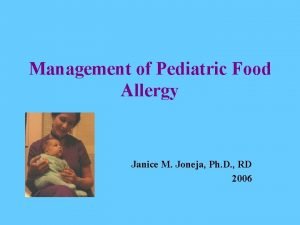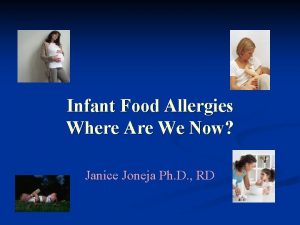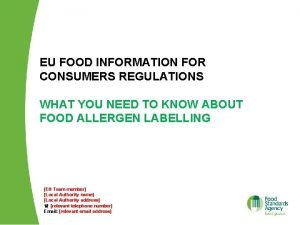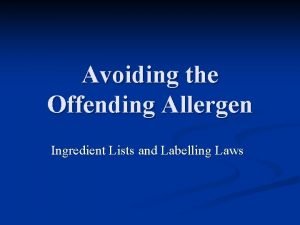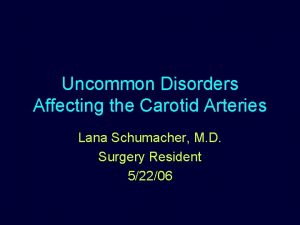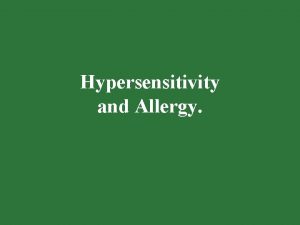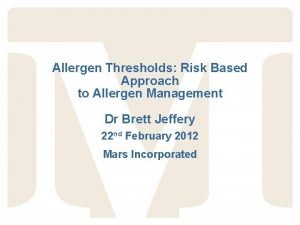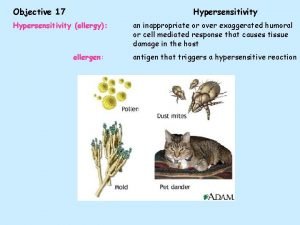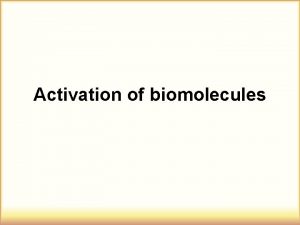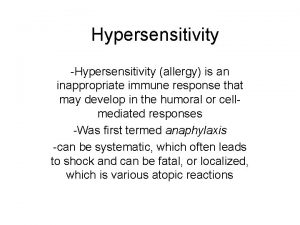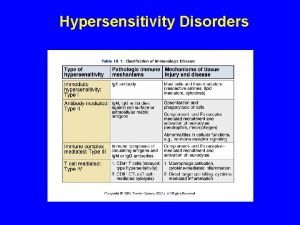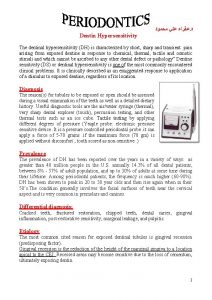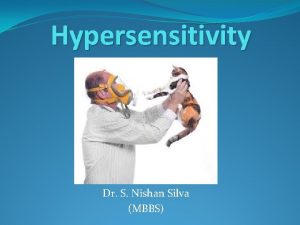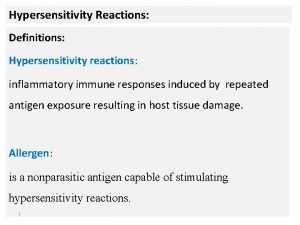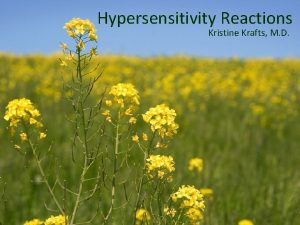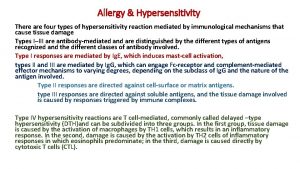hypersensitivity type I Allergen Activation of Th 2




















- Slides: 20


hypersensitivity type I *Allergen Activation of Th 2 B cell activation Ig. E binding of Ig. E to Fc receptor reexposure to Allergen pathologic reactions release of mediators

General features


Mast cell activation

Factors involve in H. S type I Allergene Th 2 cells Mast and basophil cells Fc R-I Mediators Genetic predisposition cytokines


Mast cell activation Rapid release of granule contents (degranulation)such as Histamine, tryptase, chymase, proteoglycans(heparin ) Synthesis and secretion of lipid mediators(prostaglandines , Leukotrienes) Synthesis and secretion of cytokines(IL-3, 4, 5, 6, TNF )

Mediators actions Histamine= bronchoconstrictor, vascular leak, intestinal hypermotility PGD 2=vasodilator and bronchoconstrictor , neut. Chemotaxis LTC 4=bronchoconstriction, inflammation PAF=bronchoconstriction , vasodilator, inflammation

clinical and pathologic manifestations of Type increased vascular permeability Vasodilation smooth muscle contraction local inflammation

Clinical and pathologic features Hay fever(allergic rhinitis) Increased peristalsis Bronchial asthma Anaphylaxis

Wheal and Flare reaction

Food Allergy

Introduction to food allergies Actually, only about 2 -10 % of adults and children have clinically proven true allergic reactions to food intolerance or other adverse reactions to food A true food allergy People who have food allergies must identify and prevent them because, although usually mild and not severe, these reactions can cause devastating illness and, in rare instances, can be fatal.

Food intolerance refers to an adverse physiologic response to a food and may be due to inherent properties of the food a)toxic contaminant b)pharmacologic active component or to characteristics of the host a)metabolic disorders b)idiosyncratic responses c)Psychological disorder **** they may not be reproducible *** they are often dose dependent. Food allergy refers to an abnormal immunologic response to a food that occurs in a susceptible host. a)These reactions are reproducible each time the food is ingested b) they are often not dose dependent

Histamine toxicity: Some natural substances (for example, histamine) in foods can cause reactions resembling allergy. Histamine can reach high levels in cheese, some wines, and certain fish Food additives: Another type of food intolerance is an adverse reaction to certain compounds that are added to food to enhance taste, provide color, or protect against the growth of microorganisms. The compounds most frequently tied to adverse reactions that can be confused with food allergy are : yellow dye number 5(tartrazine) monosodium glutamate (MSG) and sulfites.

What are the most common food allergies? In adults, the most common foods that cause allergic reactions are shellfish, such as shrimp, lobster, nuts from trees, such as walnuts; fish; eggs and peanuts. In children, the pattern is somewhat different from adults, and the most common foods that cause allergic reactions are eggs, milk, peanuts, and fruits, particularly tomatoes and strawberries.

Food allergy varieties Based on the immunological mechanism involved, food allergies may be further classified in : a)Ig. E-mediated b) Cell mediated c) mixed Ig. E mediated-cell mediated when both Ig. E and immune cells are involved in the reaction

Ig. E-mediated classic food allergic reactions are those that are: immediate reproducible and readily diagnosed by detection of food-specific Ig. E

Characteristics common to “major” food allergens are that : they are water-soluble glycoproteins, are 10 to 70 k. D in size and are relatively stable to heat, acid, and proteases. Frequent exposure High glycosylation In addition, the presence of immunostimulatory factors in the food may also contribute to such sensitization. However, the biochemical characteristics of a food allergen cannot explain alone , as only a minority of patient exposed to it develop allergy.
 Activation tree and activation record
Activation tree and activation record Type 2 hypersensitivity
Type 2 hypersensitivity Serum sickness hypersensitivity type
Serum sickness hypersensitivity type Hygiene hypothesis
Hygiene hypothesis Innate defination
Innate defination Delayed type hypersensitivity reactions
Delayed type hypersensitivity reactions Examples of type 2 hypersensitivity
Examples of type 2 hypersensitivity Dermatomyositis hypersensitivity type
Dermatomyositis hypersensitivity type Fishnet appearance
Fishnet appearance Idph allergen awareness
Idph allergen awareness Control ctrl allergen
Control ctrl allergen Menu with allergen information
Menu with allergen information Raw template
Raw template Joneja allergen chart
Joneja allergen chart Plain english allergen labelling
Plain english allergen labelling Joneja allergen chart
Joneja allergen chart Fsa allergy chef cards
Fsa allergy chef cards Avoid the offending allergen that
Avoid the offending allergen that Dental hypersensitivity
Dental hypersensitivity Lana schumacher md
Lana schumacher md Classification of hypersensitivity
Classification of hypersensitivity

